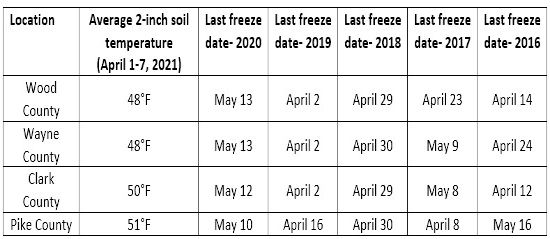By Alexander Lindsey and Laura Lindsey
Figure 1. Freeze damage below the cotyledons. The soybean plant will not recover.
Planting when conditions are adequate (soil temperatures above 50°F and greater than 45% plant available water content) is recommended for corn and soybean. This year, these conditions are occurring sooner than normal. At a two-inch depth, average soil temperature ranged from 48 to 51°F between April 1 and April 7 (Table 1). In general, early planting helps increase yield potential of both corn and soybean. For soybean, each day delay in planting after May 1 results in a yield decrease of 0.25 to 1 bu/acre/day. Additionally, there is also the real observation of the last few years that if you don’t get planted early, rains in May could prevent planting all together (thinking of you, 2019). While there are benefits of early planting, there are also risks that should be considered (especially if the weather turns cool).

Table 1. Average two-inch soil temperature from April 1 through April 7, 2021 and last freeze date (air temperature ≤32°F) for the past five years. (Data from CFAES Weather System: https://www.oardc.ohio-state.edu/weather1/).
The first step in germination is the process of imbibition, or absorbing water from the soil for 24-48 hours after planting. Generally, seeds need to return to their moisture levels at physiological maturity (30% moisture for corn, 50-55% for soybean) before germination begins. The temperature of the water should be above 50°F during this process or it can damage the cells in the seed (referred to as ‘imbibitional chilling’). We have had imbibitional chilling occur in parts of Ohio where soil temperatures were warm (>50°F) but then we had snow or cold rain within 12 hours of planting, which damaged seedlings and contributed to poor stands or seed mortality (forcing replant).
The second phase of germination called the lag or activation phase involves seed reserve mobilization and cell wall loosening. Cool temperatures can slow this phase, which can affect how quickly the seeds will sprout. The final step is growth and is marked by radicle emergence. The seed is now fully committed to growth and must rely on internal food reserves to fuel growth until it emerges and can start photosynthesizing. Rate of growth is influenced by accumulated growing degree days (GDDs) or heat units. If days turn cooler after planting, fewer GDDs are gained each day resulting in more days in the soil without photosynthesizing. This can deplete seed reserves. Recent work from Ohio (2017-2019) suggests 155 soil GDDs after planting are needed to facilitate corn emergence without incurring a yield penalty.
After emergence, growth in corn is fueled by GDD accumulation. Late frosts can damage leaf tissue, but the growing point remains belowground for corn until V6 growth stage (approximately 550-600 GDDs from planting). If the growing point is not damaged, the plant should be able to re-grow and no yield loss is expected. (Complete defoliation of corn through the V5 growth stage resulted in no yield loss.) For soybean, the growing point is above the soil surface at emergence (VE growth stage). If freeze damage occurs below the cotyledons, the plant will not recover (Figure 1). The last freeze date (air temperature ≤32°F) for the past five years has ranged from as early as April 2 to as late as May 16. However, a temperature of ≤32°F does not necessarily mean there will be freeze damage. Freeze damage can be variable based on soil moisture, landscape position, and crop residue in the field. Also, keep in mind, reported air temperatures are usually from several feet above the soil surface. Temperatures near the soil are often warmer, especially when the soil is wetter. If we do encounter a drop in temperature, wait at least five days to check your plants for damage.
One final consideration with planting early is planting depth. Shallower planted seeds will accumulate GDDs faster than deeper-planted seeds, which may result in more rapid emergence. However, moisture for imbibition tends to be more variable at shallow depths, which can lead to: i) greater fluctuations in temperatures (high temperatures will be greater and low temperatures will be lower compared to deeper planted seeds); and ii) less uniform emergence (takes longer to get all plants to emerge), which can ultimately cause yield decreases. Additionally, the crown of the plant (where the growing point resides) may be closer to the soil surface if planted shallow. This means there is less protection for the crown if temperatures drop unexpectedly prior to V6 growth stage of corn, possibly causing damage to the growing point. Shallow planting can also result in poor nodal root formation in the season and may cause rootless or floppy corn syndrome to develop at the V4-6 growth stages.
Source : osu.edu